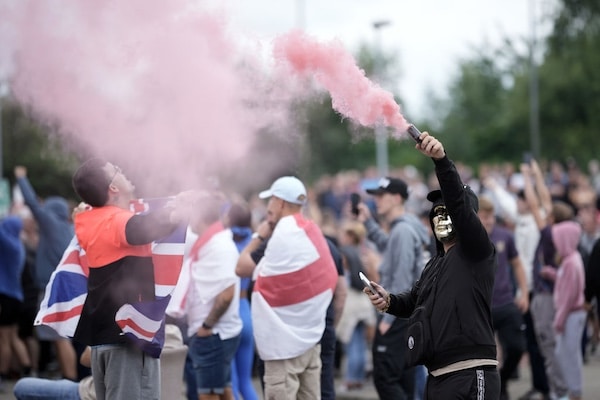Across the country, fascists are committing horrendous acts of racist violence in broad daylight. In Rotherham and Tamworth, hotels housing asylum seekers were set on fire; in Burnley, Muslim graves were vandalized. On social media, videos are said to show young people beating those they perceive to be Muslims in the street. In one post from Hull, a man is pulled from his car and physically assaulted by a group of masked men.
These incidents were sparked by the murder of three young girls at a Taylor Swift-themed dance class. The perpetrator was born in Britain to a Christian family. That hasn’t stopped far-right groups from weaponising their deaths to further their Islamophobic and anti-immigration agenda.
The violence of the last week has been unusually vicious and frightening, but it does not exist in a vacuum. Fourteen years of Conservative rule have seen minority communities used as a scapegoat for worsening inequality time and time again. The history of institutional racism in Britain goes back much further, but you could begin the most recent version of this story at the introduction of the Hostile Environment, a set of policies that aimed to make Britain feel inhospitable. This feeling was only meant to be sensed by illegal immigrants, according to its architects David Cameron and Theresa May, but its effects travelled much further. In making it illegal for undocumented migrants to access state support, get jobs, or rent properties, the government created a culture of suspicion around all migrants, and sometimes all people of colour. Growing numbers of civil society figures, including doctors and teachers, were tasked with checking individuals’ immigration statuses, a culture of surveillance that perpetuated a false dichotomy of the ‘good/bad’ immigrant. Scandal after scandal followed, revealing the horrific abuse of asylum seekers at the hands of the Home Office, the deportation of many Windrush citizens, and a rise in racist hate crimes.
Taking place alongside this process was another which saw the media relentlessly demonise non-white migrants and asylum seekers, often through an Islamophobic lens. AsNoam Chomsky has observed, after 9/11, Muslims replaced Communists as the ‘common enemy’ of the West, a collective feeling that was designed to manufacture consent for the War on Terror (the devastation of which has only driven more from the countries it affected to seek security in Europe). A landmark 2021 study of the British press found that ’60 percent of articles across all publications were identified as associating negative aspects and behaviour with Muslims,’ with one in four conflating Islam with terrorism.
While the Conservative Party and right-wing press laid the foundations for what we are witnessing this week, then, the Labour right must also take its share of responsibility. New Labour helped to embed the Islamophobia of the post-9/11 years, with new, stronger powers of policing and surveillance and campaign literature that demonised asylum seekers. Keir Starmer appears to be taking up this mantle: the party’s position on immigration in this election pandered to the far-right and legitimised the ‘othering’ of asylum seekers. In their manifesto, Starmer’s Labour promised that they would ‘control’ immigration and ‘remove‘ people ‘who have no right to be here’. When answering questions from an audience of Sun readers, Starmer selected a specific target, lamenting that ‘people coming from countries like Bangladesh are not being removed’–words that led to the resignation of Sabina Akhtar, a Bangladeshi Labour councillor.
The new Labour government did scrap the Conservatives’ plan to send immigrants to Rwanda, but this was positioned as a financial decision rather than a moral one: Starmer called it an ‘expensive gimmick’. The move was followed up by a renewed pledge to ‘smash the criminal gangs’ involved in small boat crossings by using anti-terror powers, a connection that once again fuels the villainization of refugees. Just this week, Sarah Edwards, the Labour MP for Tamworth, referred to the town’s Holiday Inn as an ‘asylum hotel’ and said that the town’s people wanted ‘their hotel back’. Days later it was set alight by the far-right.
In the last ten months, our screens have displayed the annihilation of an estimated 40,000 Palestinian people at the hands of Israel–people crushed under mountains of rubble, parents screaming while holding parts of their children’s bodies, testimonies of ‘horrifying‘ cases of torture at the hands of the IDF. This unimaginable violence was justified by both the Conservatives and Labour, who each parroted lines about Israel’s ‘right to self-defence’ while continuing to take donations from the Israel lobby. Events in Gaza may seem a long way away from those in Southport, but the implications of the apologism demonstrated by Britain’s mainstream politicians is that Muslim and Arab lives are not valued–a message not lost on the far right. It is difficult to imagine how different the reaction to these images would be if the victims were white.
As academics like Neil Ewen note, the new Labour government has yet to offer a viable solution to the economic disaster marking Britain today. Sky-high rents, widespread food poverty, and a burning planet are just three of the consequences of the problem politicians won’t talk about: an economic system that prioritises the wealthy at the expense of society. The Labour government’s plans to continue austerity politics (described by the United Nations as an ‘experiment’ upon the nation’s most vulnerable) will only deepen the resentment on which the far-right feeds. This is, of course, a choice, and one Labour will likely continue to make even as the riots rage on. We should remember this each time Starmer appears on our TV screens to shake his head and condemn the rioters’ actions. They are worthy of condemnation, of course, and should be dealt with by the police. But who is dealing with the thugs in Westminster?

